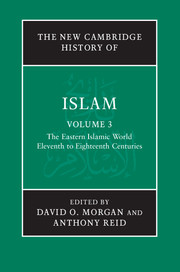Book contents
- Frontmatter
- Introduction: Islam in a plural Asia
- PART I THE IMPACT OF THE STEPPE PEOPLES
- 1 The steppe peoples in the Islamic world
- 2 The early expansion of Islam in India
- 3 Muslim India: the Delhi sultanate
- 4 The rule of the infidels: the Mongols and the Islamic world
- 5 Tamerlane and his descendants: from paladins to patrons
- PART II THE GUNPOWDER EMPIRES
- PART III THE MARITIME OECUMENE
- PART IV THEMES
- Glossary
- Bibliography
- Index
- References
4 - The rule of the infidels: the Mongols and the Islamic world
from PART I - THE IMPACT OF THE STEPPE PEOPLES
Published online by Cambridge University Press: 28 March 2011
- Frontmatter
- Introduction: Islam in a plural Asia
- PART I THE IMPACT OF THE STEPPE PEOPLES
- 1 The steppe peoples in the Islamic world
- 2 The early expansion of Islam in India
- 3 Muslim India: the Delhi sultanate
- 4 The rule of the infidels: the Mongols and the Islamic world
- 5 Tamerlane and his descendants: from paladins to patrons
- PART II THE GUNPOWDER EMPIRES
- PART III THE MARITIME OECUMENE
- PART IV THEMES
- Glossary
- Bibliography
- Index
- References
Summary
The formation of the Mongol empire
The Mongol period was a watershed for the Islamic world, as it was for most of Eurasia. The ferocity of the conquest and the confusion of early rule exacerbated an agricultural decline already deepened by decades of internal warfare. For artisans and merchants, however, the period brought significant new opportunities. As foreign nomads, the Mongols were not a novelty, and eastern regions had already experienced the rule of the non-Muslim Qara Khitay. However, the Mongols replaced the familiar caliphate with a new imperial ideal and administrative methods conceived and tested in Mongolia and China. While the Chinggisid rulers were quick to adopt the bureaucratic practices of conquered territories, they did so within a framework conceived at the beginning of Chinggis Khan’s rule; thus steppe traditions lay at the base of Mongol administration.
The political and economic connections of the Mongolian plateau reached from northern China to western Turkistān (see Map 2). Its southern sections were closely involved with China and the Silk Road and sometimes in contact with powers to the west. In the northern forest region many tribes lived from hunting and fishing or reindeer herding, while in the steppe pastoral-nomadism prevailed. There were also agricultural settlements. Two related languages, Turkic and Mongolian, predominated, sometimes spoken within one confederation. The most powerful populations were the pastoral nomads, and it is probably not by chance that the Mongols set their myth of origin in the time and place of their transition to pastoralism.
- Type
- Chapter
- Information
- The New Cambridge History of Islam , pp. 128 - 168Publisher: Cambridge University PressPrint publication year: 2010
References
- 4
- Cited by



